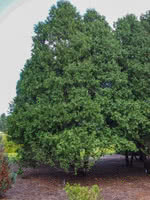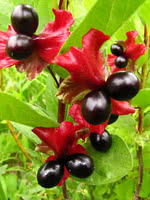Mon-Fri 9am - 5pm Mountain time
Eastern White Cedar (Arborvitae) vs Bracted Honeysuckle
Thuja occidentalis
Lonicera involucrata
NOT AVAILABLE THIS SEASON - MIGHT RETURN
Eastern White Cedar is a slender growing conifer often used as a decorative tree or a hedge. This tree is an effective privacy screen even in winter and a great long term solution to urban crowding or a drab yard.
Bracted Honeysuckle is a shade loving shrub that is distinguishable from other honeysuckles by its square stem and pointed leaves. Native to most of North America, this honeysuckle is found along swamps, rivers, riparian zones and moist wooded areas.
If you have a erosion control project in mind, consider Bracted Honeysuckle.

